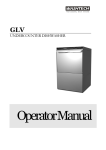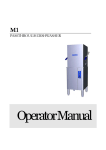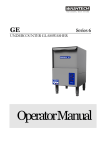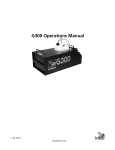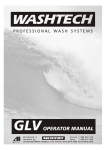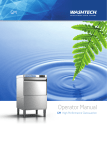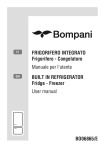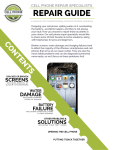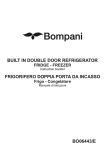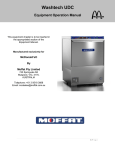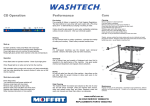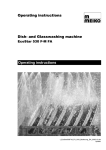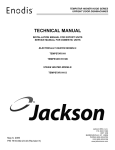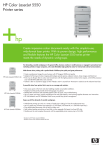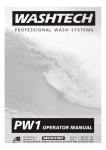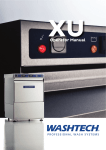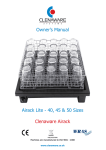Download Operation Manual
Transcript
PW1 Series 3 HIGH PERFORMANCE POTWASHER OperatorManual WARNING Before installation and commissioning, you must read the safety instructions and warnings carefully and all the warning labels attached to the equipment. ! ! IMPORTANT Failure to comply (even partially) with the instructions given in this manual will invalidate the product warranty and relieves the manufacturer of any responsibility. IMPORTANT The alteration of machine operation, design or the replacement of parts not approved by the manufacturer may void warranties and approvals. We have checked that the contents of this document correspond to the model described. There may be discrepancies nevertheless, and no guarantee can be given that they are completely identical. The information contained in this document is reviewed regularly and any necessary changes will be included in the next edition. We welcome suggestions for improvement. Document subject to change without prior notice. Information supplied in this manual is copyright. No part of this work may be reproduced or copied in any form or by any means, electronic or mechanical without the express permission of the author / publisher. Safety Instructions WARNING Equipment contains dangerous voltages and can be hazardous if installed or operated incorrectly. Non-compliance with Warnings or failure to follow the instructions contained in this manual can result in loss of life, severe personal injury or serious damage to property. Installation Use qualified, skilled personnel Follow installation instructions Connect to correct voltage and supply current Provide fully accessible Electrical Isolation Switch & water supply valves Training and Supervision Read and Understand the Operating instructions and train all staff This appliance must not be operated by children or infirm persons Machine panels must only be removed by suitably qualified and trained personnel – internal hazards include live electrics and very hot surfaces This appliance is not intended for use as a stepladder Hot Surfaces Some surfaces may be hot or very hot Chemicals Commercial dishwashing detergents are hazardous – handle with care Read and follow the safety information found on the labels of detergent containers and Material Safety Data Sheets Use protective eyewear and clothing if decanting containers Hot Water Do not put hands in wash water which may be over 60°C and contain hazardous caustic detergent Rinse water can be over 90°C Door safety switches are designed for emergency use only Cleaning Do not hose down the machine or splash water over the exterior Watch for broken glass etc when cleaning the inside of the machine Service/Repair Under no circumstances the user should attempt to carry out repairs All service/repair work must be carried out by qualified personnel only Installation WARNING Installer must be suitably qualified and ensure compliance with all codes and standards including AS/NZS3500.1. ! Failure to comply even partially with installation instructions may void the warranty. Positioning Unpack machine, check for damage and complete delivery. Install machine on sound waterproof self-draining floor and use adjustable feet to level machine. Allow room for detergent to one side of machine or in adjacent cupboard. 20litre container requires about 450H x 250W x 350D, but smaller containers are available from many suppliers. Water Supply Hot water temperature Connection Flow rate minimum Consumption per cycle Backflow prevention Pressure 65°C ± 5°C 20 mm (3/4" BSP Male) 20 litres per minute 3.5 litres approximately Dual Check Valve fitted standard 200-350 KPa = 30-50 Psi. Above this range fit pressure limiter. Don’t use small diameter plastic supply lines especially below this range when optional rinse booster pump may be required. FLUSH supply line before connection. Poor quality supply or excessive water hardness may affect performance or damage machine – filtration and/or softening is recommended. Waste 40 mm gravity drain – refer to point B on the installation diagram – run waste directly behind the machine or through open side panels or base. Power Machine requires 3 Phase, Neutral and Earth, 400/415V, 15A/ph, 50Hz, permanently wired via wall switch mounted adjacent to machine. Wash pump rotation must be checked after installation to ensure correct direction (excessive noise and damage with incorrect direction). Detergent Insert pump inlet hose into container of commercial low foam detergent. Open machine door and switch machine on. Press and hold detergent prime switch behind front cover until chemical flows into machine. Commercial detergents can be hazardous – read instructions and handle with care. Installation Checklist Complete attached Installation Checklist to ensure machine is installed and running correctly, and operator is familiar with operating procedures. Troubleshooting If the machine doesn’t fill after switching on the power, check and ensure that the hot water supply tap is open, water supply pressure is not below specification and Dual Check Valve is correctly installed (arrows on the dual check valve’s body specify water flow direction). Installation Checklist CHECK Delivery Supplied complete Position Level and stable Water Isolator valve fitted DCVs fitted (Washtech only) Temperature Flow rate Pressure Cold water when required Hardness Power Isolating switch Supply as specified Waste Usually 40 mm Air gap on pumped drain Chemicals product name Detergent Rinse Aid Machine operation Run several cycles Confirm correct operation Operator training OK / NOTES no transit damage on sound, waterproof, self draining floor Accessible, all fittings sound, no leaks Correct direction 65 ± 5°C Minimum 20 litres per minute 200-350 kpa, limiter fitted if above this range Booster fitted if below this range Pressure not above 350 kpa Filter or softening if required Fitted, functional and accessible Voltage, current, circuit breaker Sound, no leaks Very important GLV and UD models container no leaks primed Including correct fill levels Confirm Operator has copy of Operator Manual and is familiar with procedures Start-up Pre-rinse and racking Machine operation Drain Clean Shut-down Model / Serial Owner Location Technician Date Signed conc.OK Operating Instructions Start up Fit drain upstand, wash pump filter, scrap trays and shut door. Turn wall power switch on and select any cycle (1, 2 or 3). Power light glows red and machine fills automatically. Wash Ready light (water symbol) glows amber when wash tank is ready. Rinse Ready light (tick symbol) glows amber when the machine is up to required temperature and ready to run. Operation Select required cycle (1, 2 or 3 for 2, 4 or 6 minutes cycle accordingly). Try cycle 3 initially and switch to faster cycles only if necessary. Load rack into machine and close door. Press Start button to start the machine. Cycle light glows green while machine operates. When Cycle light goes out, cycle is complete. Open door and remove rack. NOTE: Machine will not operate unless Ready lights are on. Shut down every night Turn machine and wall power switches off. Remove drain upstand to drain wash tank. Remove scrap trays and wash pump filter and rinse clean. Replace drain upstand, filter and scrap trays. Dishwashing Procedures for best results Note : these are general instructions to assist in getting the best performance from Washtech dishwashers – some comments and / or illustrations may not apply to every unit. Installation Read the Operator Manual. Correct installation, including an adequate supply of water at the correct temperature and pressure is essential for effective operation of your machine. Refer installation instructions for details. Drain hose outlet height is important on some models. Always install on a sound self-draining floor. Water softening is recommended in hard water areas - especially for glasswashing Pre-rinsing Pre-scraping of dishes is required by hygiene regulations. The best method is to pre-rinse with a pre-rinse spray unit or alternatively by scraping or dunking in water. Cutlery Procedures Pre-soak cutlery in warm water, preferably containing cutlery pre-soak compound - refer your chemical supplier. Do not overfill cutlery containers. Cutlery should be loose with handles down. Sort after washing rather than before. Cutlery of only one type nests together and obscures wash water. Racking Procedures Do not overload racks, minimize the overlap of crockery. Cycle times are short and water consumption per cycle low - so there is no advantage in overloading racks. Cycle Times For multi-cycle machine use the longest cycle whenever possible. Note that water consumption does not increase with longer cycles. Only choose shorter, faster cycles when necessary. Detergent Use of correct type and quantity of low foaming commercial grade detergent is essential to the performance of the machine. We strongly recommend that you use a professional dishmachine chemical supplier - and will be pleased to recommend a supplier in your region. Discuss with them the use of cutlery pre-soak solution, detergent and drying agent. Dishwashing Procedures for best results Drying Single tank commercial dishwashers do not have a drying cycle. However, the machines do rinse at high temperatures which promote fast drying particularly when drying agents are used. We recommend prompt removal of the rack from the machine - leave the rack on the bench for 2 to 3 minutes before emptying. This time will be reduced with correct use of drying agent (rinse fluid) which reduces water surface tension and allows water to drain quickly from washware. For advice on drying agents and injectors refer to your chemical supplier. Daily Cleaning It is essential that the machine is drained and cleaned at the end of each day. Drain the machine then remove, clean and replace filters as per the operating instructions. Regularly check the wash and rinse jets and clean them if necessary – see below. Regular Cleaning Remove scrap trays1 and wash pump inlet filter2, where fitted, and rinse or brush clean. Remove wash and rinse arms by undoing the central thumbscrews3. If necessary, remove the end cap screws4 from the wash arms and the end screws5 from the rinse arms and flush the arms with water and/or use a toothpick or paperclip to clear jets. Note: arms and filters vary with model and may appear different from this illustration e.g. those models with plastic wash arms have removable jets for ease of cleaning Regular Servicing Regular servicing of the dishwasher is absolutely essential to keep the machine in top working condition and obtain the best performance. Please contact Moffat or your Authorised Service Provider to organize regular servicing of the dishwasher - discuss a Preventative Maintenance Agreement for optimum performance and long machine life. Note : these are general instructions to assist in getting the best performance from Washtech dishwashers – some comments and / or illustrations may not apply to every unit. Notes











